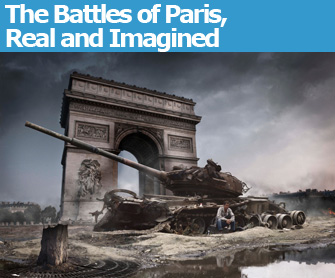 |
|
Imagined war scene at the Arc de Triomphe © Parrick Chauvel. Photomontage: Paul Biota |
On my way to the exhibition “Peurs sur la Ville: Violences Urbaines à Paris” at the Monnaie de Paris the other day, I noticed a plaque on the sidewalk on Rue Monsieur …
 |
|
Imagined war scene at the Arc de Triomphe © Parrick Chauvel. Photomontage: Paul Biota |
On my way to the exhibition “Peurs sur la Ville: Violences Urbaines à Paris” at the Monnaie de Paris the other day, I noticed a plaque on the sidewalk on Rue Monsieur le Prince in the very chic sixth arrondissement. It marked the spot where a student, Malik Oussekine, had been beaten to death by two policemen (although the text does not mention who did the deed) after a demonstration in 1986. These little reminders of violence and war can be found all over the streets of Paris in the form of plaques honoring by name those who fell under Nazi fire at that spot during the Liberation of Paris. Touchingly, these plaques are adorned with bouquets of flowers every year by the City of Paris.
Seeing that plaque on Rue Monsieur le Prince and wondering about the story behind it was an appropriate prelude to the exhibition, a show of documentary photos, most of them from the photo news mag Paris Match, reminding us that behind all those little memorials are dead bodies and rivers of blood.
The show begins with photos of the Liberation: middle-aged ladies in helmets womanning barricades, pretty women packing pistols, corpses on the street next to the Samaritaine department store. Next come the bloody demonstrations in Paris in 1962 after the end of the Algerian War, followed by May 1968, with images of a young, flag-waving couple in love kissing on the barricades; filmmaker Jean-Luc Godard being arrested; a lone demonstrator running from a cop with raised billy club; a line of riot police advancing on terrified demonstrators; and a man who seems to be headless because he has withdrawn turtle-like into his jacket being beaten by a cop.
The list of violent episodes goes on, with terrorists attacks in the types of places we frequent every day: six dead and 22 wounded in 1982 at the Jo Goldenberg restaurant in the Marais, where the bullet holes can still be seen in windows although the restaurant is now closed; a corpse sprawling behind the counter in the Drugstore Publicis in 1974; bombings in the Pub Renault on the Champs-Elysées and at the Hôtel de Ville in 1986; and more.
One gruesome image shows a woman lying on the sidewalk after the bombing of the Tati store on Rue de Rennes in 1986. Her bloodied face is echoed in a splash of red clothing on the right side, and her eyes are open and looking off to the side. Is she dead? We don’t know (more explanatory text would have been helpful for the entire show to clarify the circumstances surrounding these incidents and who the perpetrators were). A fallen FNAC bag in the foreground of the photo looks like a very out-of-place advertisement for the chain, one of whose stores was also bombed the same year.
The exhibition includes two shows within the show. The relationship of photographer Michael Wolf’s “I See You” to the main exhibition is something of a stretch. His blow-ups of images selected from Google Street View are meant to depict the “insidious violence” of the invasion of privacy represented by Google’s omnipresent cameras, as opposed to the direct violence of guns and bombs. They are handsome and intriguing images, however: in one we see someone’s hand and forearm, cut off by the edge of the photo, juxtaposed with the shadow of another person on the ground. Another shows a helmeted motorcyclist giving the Google camera the finger with a red-gloved hand.
The other mini-show features war photographer Patrick Chauvel’s superimpositions of his war images on pictures of Parisian monuments: the silhouettes of armed soldiers in front of a red-lit Notre Dame, for example, or tanks and rubble in front of the Arc de Triomphe. One shows soldiers and a burnt-out truck in front of the Monnaie de Paris (where the exhibition is being held), its columns singed by fire. These photomontages might look surreal if you hadn’t just seen so many real images of death and destruction in the streets of Paris. And the show as a whole will influence the way you look at the city when you step out the door.
Today, shoppers shop, tourists gape and commuters commute in the lovely streets of Paris, blissfully unaware of what happened on these very streets not so many years ago and oblivious to the fact that it could easily happen again (a possibility made all the more real by Osama bin Laden’s threats to France this past week). As French writer and Academician Max Gallo writes in the introduction: “Paris is a battleground.”
Monnaie de Paris: 11, quai de Conti, 75006 Paris. Métro: Pont Neuf, Saint-Michel or Odéon. Tel.: 01 40 46 56 66. Open Tuesday-Sunday, 11am-6pm (until 9:30pm on Thursday). Admission: €6. Through April 17. www.monnaiedeparis.fr
Support Paris Update by ordering books from Paris Update’s Amazon store at no extra cost. Click on your preferred Amazon location: U.K., France, U.S.
Reader Reaction: Click here to respond to this article (your response may be published on this page and is subject to editing).
More reviews of Paris art shows.
© 2011 Paris Update
